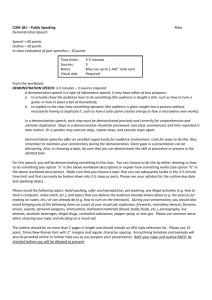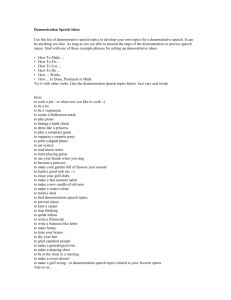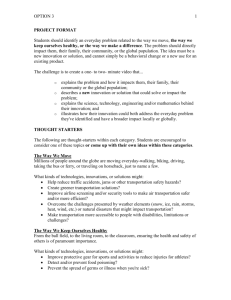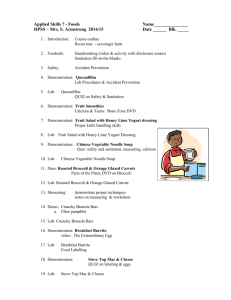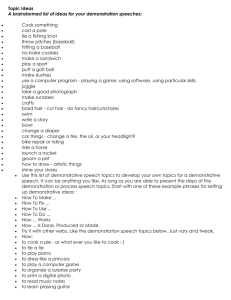overview of scheme for promoting usage of agrotextiles in north east
advertisement
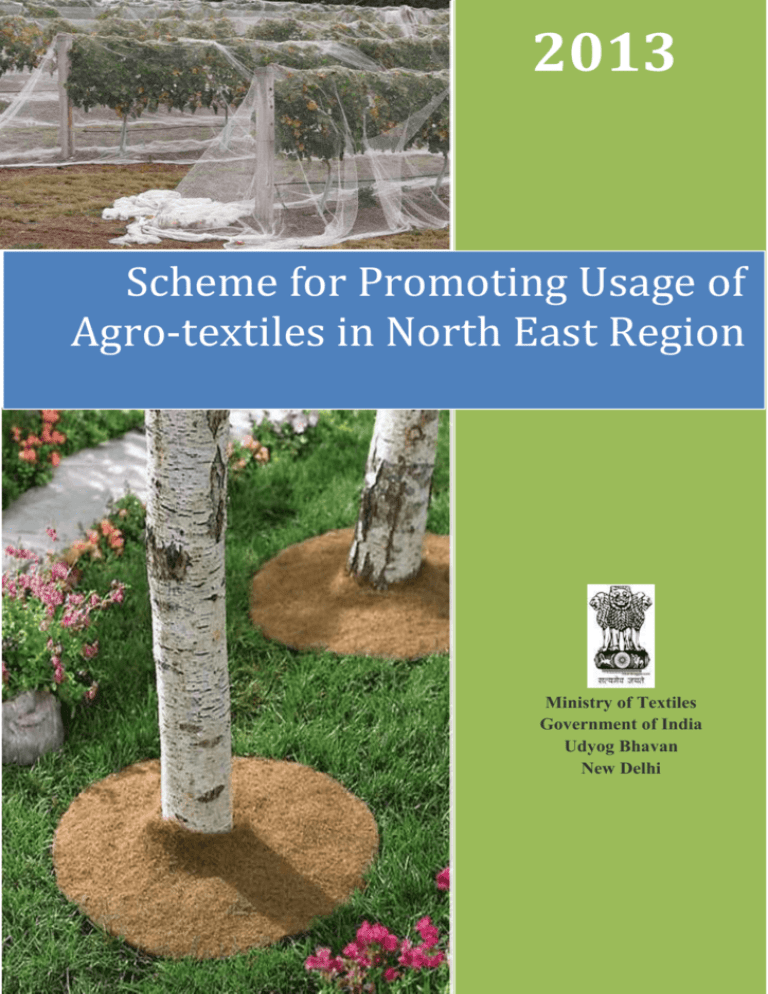
2013 Scheme for Promoting Usage of Agro-textiles in North East Region Ministry of Textiles Government of India Udyog Bhavan New Delhi 0 of 36 CONTENTS Glossary of Abbreviations Used ..................................................................................................... 2 OVERVIEW OF SCHEME FOR PROMOTING USAGE OF AGROTEXTILES IN NORTH EAST REGION ...................................................................................................... 3 1. Introduction ........................................................................................................................... 3 2. SCHEME COMPONENTS .................................................................................................. 5 3. Targets for the Scheme Components ................................................................................... 8 4. Implementation of the Scheme ........................................................................................... 10 5. Fund Allocation ................................................................................................................... 10 6. Total Cost of the scheme ..................................................................................................... 12 1 of 36 GLOSSARY OF ABBREVIATIONS USED S. No. 1 2 3 4 5 6 7 8 9 10 11 12 13 14 15 16 17 18 19 20 21 22 23 ABBREVIATION NER KVK NGO COE Agrotech SASMIRA BIS IA R&D GOI PCA TRA FICCI ICC CII ITTA TMTT OTXC PMIC AMC GFR EC DONER AS&FA UNABRIDGED North East Region of India KrishiVigyan Kendra Non-Governmental Organization Centre of Excellence for Agrotextiles Synthetic & Art Silk Mills' Research Association Bureau of Indian Standards Implementing Agency Research and Development Government of India Project Coordination Agency Textile Research Association Federation of Indian Chambers of Commerce and Industry Indian Chamber of Commerce Confederation of Indian Industry Indian Technical Textile Association Technology Mission on Technical Textiles Office of the Textile Commissioner Project Monitoring and Implementation Committee Apex Monitoring Committee General Financial Rules, Government of India Empowered Committee Ministry of Development of North Eastern Region Additional Secretary & Financial Adviser 2 of 36 OVERVIEW OF SCHEME FOR PROMOTING AGROTEXTILES IN NORTH EAST REGION USAGE OF 1. INTRODUCTION The North Eastern Region (NER) of India is composed of eight states: Arunachal Pradesh, Assam, Manipur, Meghalaya, Mizoram, Nagaland, Sikkim and Tripura. The region occupies about 5.6% of the total geographical area of the country. The varied climate, altitude, edaphic conditions, etc. lead to enriched biodiversity and formation of salubrious cultural and social environments in the region. NER can be further subdivided into three geographic regions: plain valley, medium hills and higher elevation, which house vast environment and social diversity. A large number of horticultural crops are grown in the north eastern region; crops like banana, mango, and a large number of citrus and floral species are native to this region. NER contributed nearly 4% of the country’s horticulture production in 2010-11, and is collectively the leading producer of fruits, supplying nearly 12% of India’s litchis, 47% of pineapple, and nearly 7% of the country’s citrus fruits. NER is also a leading producer of vegetables, like cabbage, cauliflower, and sweet potato, in India. Among the states of the NER, in terms of fruit production and area, Assam occupies maximum followed by Arunachal Pradesh and Tripura. Similarly in vegetable production Assam has occupied maximum in production and covered area under the crop. Given the prominence of agricultural activities in the North Eastern Region, and the significant contribution of this region to the national agriculture sector, this region will greatly benefit from the application of agrotextile technology. While agricultural activities are mostly dependent on natural conditions such as sunlight, water, climate (wind, hail, humidity), external factors (birds, weeds, insects, etc.) and post-harvest handling of produce, absence of control factors expose the region’s agricultural sector to risks of unsatisfactory yield, marred quality of produce, damages to the produce, regional limitation on cultivation, and seasonal limitation on cultivation. Figure 1: Different product mix representation in the NER 3 of 36 Agrotextiles are used in farming, animal husbandry, sericulture and horticulture to control the hazardous influences of environmental and climactic factors on crop production and cattle breeding, regulate nutrient level intake of plants, silk worm rearing and assist in process and post-harvest operations. Agrotextiles have been demonstrated to be successful world over in not only protecting the crops from any external factors, but also in improving agricultural yield. Researchers in developed countries have proven the advantages of agrotextiles in improving per hectare productivity and quality of produce, specifically for horticulture and floriculture crops, through numerous studies and onsite trials. Field trials and pilot studies have demonstrated the following benefits of usage of agrotextiles: • • • • • • • • Increased productivity (50-80%, depending upon the nature of crop) Premium quality of produce (increased income by 50-60%) All season and any region cultivation of crops Early and even ripening of produce (more harvest cycles per year) Reduced water consumption (10-15%) Minimised use of fertilizers and pesticides (25-30%) Prevention of damages owing to birds, insects, hail, sunburns, falling off of ripened fruits (100% protection) Weed control, etc. As a result, the use of Agrotextiles is increasing daily on a global level, with farmers in industrial and developed countries using agrotech products to reduce sunburn damage to crops and evaporation of irrigation water, as well as, the menace from birds and pests. Presently, common Agrotextile products like mulch mats, shade nets, soil covers, and protective nets are being used all over the world. While the cultivation of horticultural crops and floriculture crops can be further enhanced with use of protective Agrotextiles, their inclusion in the XIIth Five Year Plan is of vital importance to the national economy and agriculture sectors. Nonetheless, the northeastern region in particular is yet to adopt this innovative technology on a larger scale. It is therefore worthwhile to promote Agrotextiles in India’s north-eastern states for introducing modern cost effective technology in the NER and also to boost the economy of the states in this region. The widely used agrotextile shade net house is represented in the figure 2 below. Figure 2: Pictorial representation of shade net house module 4 of 36 The aim is to utilize Agrotextiles in improving the horticulture and floricultural produce of the NER states. With increasing acceptability of Agrotextiles, entrepreneurship in the area of agrotextiles production in the country will get an impetus. The growth of usage of Agrotextile products in the country will thus benefit both agriculturists as well as textile entrepreneurs in the country. In order to promote and increase the usage of Agrotextiles, in agriculture, horticulture/floriculture, sericulture and allied activities in the North Eastern Region, Ministry of Textiles has formulated a Scheme for Promotion of Usage of Agrotextiles in the North Eastern Region, with two components for a period of five years at a cost of Rs 55 crores. 2. SCHEME COMPONENTS The scheme components are as under: Component I. Component II. Creating awareness, setting–up of Demonstration Centres and developing capacities Provide/disburse agrotextile kits in the NER states 2.1. COMPONENT I: CREATING AWARENESS , SETTING–UP DEMONSTRATION CENTRES AND DEVELOPING CAPACITIES OF 2.1.1. This Component will have two sub-components: a. Creating awareness on usage of Agrotextile products in the North-East region of the country through a series of awareness programmes and media publicity. b. Creating demonstration set-up for demonstrating the benefit of usage of Agrotextile products suitable for the region and building local capacities in collaboration with the agrotextile manufacturers and relevant State Agriculture bodies, Agriculture Universities, Krishi Vigyan Kendras (KVK), NGOs, etc. 2.1.2. The first sub-component will be addressed through following interventions: i. ii. iii. iv. v. vi. Organizing seminars/workshops for farmers and other beneficiary stakeholders Publication of articles on advantages of usage of agrotextile products in local magazines, new publications focused towards agriculture Promotion of usage of Agrotextiles by participation in agricultural and allied exhibitions by Indian manufacturers and suppliers of agrotextile products Publicity via radio channels in local language Publicity via television programmes focused on cultivators. Any other activity related to the above objectives. 5 of 36 2.1.3. The second sub-component is for creating demonstration set-up to demonstrate the benefit of usage of Agrotextile products suitable for the region, in collaboration with agrotextile manufacturers and relevant State Agriculture bodies/universities, Krishi Vigyan Kendras(KVK), NGOs, etc with technical support from the COE. The demonstration centers will be established to demonstrate the individual application of agrotextile products with different combinations as per the requirement and produce of the region. Such demo centers may consist of the following indicative list of agrotextile products: i. ii. iii. iv. v. vi. vii. viii. Shade net house Ground Cover Hail protection nets Bird protection house Vermicompost bed Fencing nets Wind-breaking nets Low tunnel for crop protection Figure 3: Representation of low Tunnel /Crop Cover 2.1.4. This sub-component-II will comprise of the following activities: a. Identification of State Agriculture/sericulture bodies/universities, KVKs, NGOs, etc. with expertise in protective cultivation in the region by the concerned State Govt.s that would provide land and premises for creating demonstration centers: State Agriculture bodies, KVKs, NGOs, etc. b. Identification of suppliers of relevant agrotextile products and installation thereof: The manufacturers of relevant agrotextile products with the capacity to install and maintain the demonstration centers will be eligible for establishing demonstration centers. They will empanelled by Centre of Excellence for Agrotextiles, SASMIRA, COE Agrotech through an opentender process based on certain criteria to be defined in the corresponding Request for Proposal; 6 of 36 c. The demo centre shall be jointly run by the of State Agriculture bodies/universities, KVKs, NGOs who provide the land and the supplier/installer of the demo-centre. They will also be jointly responsible for capacity building programmes for the farmers and other stakeholders in the region. d. Planning and layout for installation of the products: Technical design and layout of the demonstration centers would be provided by COE: Agrotech in consultation with agriculture experts, Agriculture Universities, KVKs, etc. to suit the regional and crop needs; e. Installation of facilities at the demonstration center: On the basis of the design, layout and specification provided by COE Agrotech, the supplier/installer shall carryout the installation of relevant agrotextile and associated material; f. Monitoring the performance in terms of crop growth, quality of produce and yield parameters: State Agriculture bodies, KVKs, Agriculture Universities/COE Agrotech, etc. will monitor the performance and efficacy of the use of Agrotech products and submit reports/ data and other inputs, for evaluation of the scheme from time to time. MIS formats to be prepared by COE with agrotextile experts 2.1.5. Apart from the above further interventions; developmental activities and R&D efforts to be undertaken by COE Agrotech under the scheme are as follows: a. Based on the demonstration trials, as at 2.1.3 above in these demonstration centres, the specifications of the products suitable for the NER would be developed to enable their manufacturing in the country and will be recommended to BIS and other standards-monitoring agencies, as necessary. b. Apart from demonstration set-up, further extrapolation of suitability of Agrotextiles to other crops in the NER would be carried out based on laboratory simulation studies by COE Agrotech. Study on the performance of various types of Agrotextiles laboratory tests and simulation modeling for their influence on control of environmental factors like soil, temperature, heat and light and also the plant growth will be carried out. c. After establishment of the improvement in the yield in qualitative and quantitative terms, COE Agrotech will perform the cost – benefit analysis of the agrotextile products to find economic viability of use of these products in agriculture, sericulture, horticulture and allied areas. d. COE Agrotech would assist in preparation of the standard specification for the Agrotextile products to be used for the NER to be approved by appropriate 7 of 36 authorities. The Centre of Excellence will also assist in development and certification of Agrotextile products. e. Schemes for appropriate incentives to be worked out in consultation with State Agriculture Departments so as to popularize the usage of Agrotextiles in the NER. f. Develop Capacities amongst the State Governments and other agencies like Krishi Vigyan Kendras and dissemination of project results to the end users and the stakeholders. Continued dissemination of information with awareness programmes as well as buyer-sellers meet would empower the region with protective cultivation practices. The farmers would be assisted through trainings/ workshops on proper cultivation practices on usage of Agrotextile products. g. Facilitating backward-forward market linkages for demand and supply of agrotextile products to ensure availability, access and adequate consumption of agrotextile products in NER, while promoting the growth of entrepreneurs and support systems in this segment. 2.2. COMPONENT II: DISTRIBUTION OF AGRO-TEXTILE KITS IN THE NER STATES: 2.2.1. This Component envisages: a. Providing ready agrotextile kits to beneficiary farmers containing the material, instructions, right methods and practices when using agrotextile products; b. Installation of the kits c. Handholding support in usage of agriculture kits. 3. TARGETS FOR THE SCHEME COMPONENTS 3.1. COMPONENT I: CREATING AWARENESS, SETTING–UP DEMONSTRATION CENTRES AND DEVELOPING CAPACITIES: OF Within the overall allocation of funds, the scheme is likely to support the following indicative number of demo centres in all 8 NER states: a. Number of demonstration centers per State: 3 to 4 b. Total number of demonstration centers to be established: 24 to 32 8 of 36 3.2. COMPONENT II: DISTRIBUTION OF AGROTEXTILE KITS IN THE NER STATES: Agrotextile kits will be disbursed to the beneficiaries (local farmers/sericulturists/horticulturists etc). Central Government will bear 90% of the costs of the kits, and the remaining 10% will be borne by the beneficiary. The beneficiaries may be encouraged to avail items in the kit in various combinations to yield maximum benefits, or any single item as per the requirement, based on actual expenditure subject to the overall ceiling of Rs 5 Lakhs per beneficiary. The supplied agrotextile products will be BIS Standards compliant (if available) or would be certified by COE- Agrotech. At least 700 kits may be disbursed to the farmers in 8 states during the period. Dovetailing with existing State Government schemes may also be considered by AMC for supporting expense of 10% of cost for agrotextile kits to be borne by beneficiaries. Figure 4: Vermicomposting under shade net house module 9 of 36 4. IMPLEMENTATION OF THE SCHEME Textiles Commissioner, Mumbai, will be the nodal officer directly in charge for the scheme and OTXC will act as the Implementing Agency (IA) for the Project. 5. FUND ALLOCATION 5.1. COMPONENT-I: CREATING AWARENESS , SETTING–UP DEMONSTRATION CENTRES AND DEVELOPING CAPACITIES OF Indicative costs for establishment and operation per demonstration center: Estimated Costs (in Lakhs) Cost for creating awareness and other costs for soft interventions for five years 1 Workshops / Seminars / Promotional efforts, etc. 226.00 2 Market studies / User Manual/ Publications material, etc. 80.00 3 Market Development Support 50.00 4 Hiring of experts / consultants 150.00 Testing, products customization, simulation modeling, R&D 5 100.00 activities, etc. Independent Evaluation (midterm and end term) of entire 6 50.00 scheme Sub Total A 656.00 Setting–up of demonstration centres in all 8 NER states for three years Establishment and maintenance of demonstration center 1 (including cost of agricultural material, manpower and utility and labour for 3 years) S. No. 2 Description Capacity building of farmers and other stakeholders Sub Total B: Approximate Cost of Demonstration centers Total (A+B) 944.00 1600.00 5.1.1. Demonstration centre Modules A typical demonstration centre may have the following combination of agrotextiles product demonstration depending upon the agro-climatic condition and agro-product mix targeted in the demonstration center. The cost of each demo-centre may, therefore, vary depending upon the modules being demonstrated in that particular centre and the size of the centre within the overall scheme budget. a. b. c. d. e. f. Shade net + Ground Cover + Crop covers Ground cover + Shade net + Bird protection nets Shade net + Vermicompost bed + Anti-hail Net Ground Cover + Crop covers + Vermicompost bed Bird protection nets + Ground Cover + Crop covers Anti-hail Net + Ground Cover + Crop covers 10 of 36 Figure 5: Representation of Ground cover module 5.1.2. Duration of operation and support under the scheme Each demonstration centre so established under this scheme shall be financially and technologically supported for a period of 3 years under this scheme. Thereafter, the pilot demonstration centers are expected to achieve self-sufficiency. The State Governments will be encouraged to work out a legacy plan to continue the demonstration centres through the owners of the centres. The support to the demonstration center may, however, be continued beyond the 3-year under the scheme if found to be useful, whereby new technologies could be attempted to be showcased as a permanent working exhibitions for agrotech products. 5.2. COMPONENT II: PROVIDE/DISBURSE AGROTEXTILE KITS IN THE NER STATES To supplement the technology demonstration through the establishment of demonstration centres in each state in the NER agrotextiles kits shall also be distributed to eligible farmers/horticulturists/sericulturists etc. during the 5 year period of the scheme at a total cost of Rs 36.50 Cr. The kits will consist of any one or more of the agrotextiles material listed at para 2.1.3 above along with its accessories/structural material depending upon the local conditions. However, total cost of agrotextiles kits to be distributed to a beneficiary under the scheme shall not exceed Rs 5.0 lakhs per beneficiary. The GOI will bear 90% of the cost of the kit and the beneficiary will bear the remaining 10% of the cost. However, concerned State government entities may support the beneficiary to bear the beneficiary’s cost share of the agrotextile kit as they deem fit under their own schemes/programs. 5.3. PROJECT COORDINATING AGENCY (PCA) A Project Coordinating Agency (PCA) will be engaged for the scheme who will do the onsite monitoring and ensure co-ordination among all partners and stakeholders of the scheme. 11 of 36 6. TOTAL COST OF THE SCHEME Cost of Component –I : Cost of Component- II: Total Cost of Component-I & II: Administrative Cost @4.5% of project cost: Total Cost of the Scheme: Rs 16.00 Crs Rs 36.50 Crs Rs 52.50 Crs Rs 2.50 Crs Rs 55.00 Crs 6.1. PROJECT ADMINISTRATION CHARGES Project administration charges will include administrative/ concurrent Monitoring such as fee of engaging PCA, meeting expenses, local travel expenses, TA/DA expenses to COE Agrotech, etc. A total of Rs 250 lakhs is estimated to be provisioned for administration expenses, at 4.5% of the total project cost of Rs 55 crores. 6.2. YEAR-WISE COSTS OF THE SCHEME The estimated duration of the project is 5 years with effect from the date of inception of the project. Year-wise schedule for financial costs to be incurred Component 1 Component 2 Administrative cost Total Year 1 Year 2 Year 3 Year 4 Year 5 78 802 275 100 1177 515 695 50 1260 125 1230 50 1405 80 1450 50 1580 78 Total (Rs in Lakhs) 1,600.00 3,650.00 250.00 5,500.00 The bulk of the expenses under this scheme are expected to be non-recurring expenses, committed towards the establishment of the demonstration centers (Component – I) and distribution of Agrotextiles kit (Component – II). Approximately 20% of the expenses will be expected to be recurring expenses that will fund the maintenance and continual operation of the demonstration centers under the NER Agrotech scheme. The above-mentioned year-wise cost estimation for individual activities and components of the scheme are indicative and can be re-appropriated within the overall approved budget based on experience gained subject to approval from Empowered Committee. ***** 12 of 36
